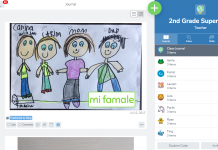
by Lee Danesco
“‘The role of parents in education is of such importance that it is almost impossible to provide an adequate substitute.’”
—Catechism of the Catholic Church, n. 2221
Sadly, parents are often overwhelmed with demands. As a result, many parents rely solely on parish programs for their children’s religious education. They respect and appreciate the efforts of catechists and catechetical leaders but allow their own role to be little more than a means of transportation to classes.
By making a place for parents in the religious education classroom, you give parents a chance to reverse this trend. Being part of religious education lessons in the classroom gives parents experiences that can empower them to carry on faith-related conversations and activities with their children at home.
Let’s explore the benefits to you, your students, their parents, and your parish community when your lesson plans make room for parents.
Benefits for You
Catechists who invite parents to join in a planned lesson quickly discover that parents seldom arrive empty handed. Instead, they bring with them, to varying degrees, commodities that sometimes are in short supply—like energy, patience, humor, and compassion. Parents can reduce your workload by assuming classroom tasks such as taking attendance, giving one-on-one attention to children as needed, distributing supplies, or monitoring small-group learning activities.
Don’t be surprised if some parents are equipped with special giftedness that allows them to enrich activities that revolve around art, drama, music, computers, or crafts. You might even be blessed with parents who have the confidence or experience to take on supportive teaching roles such as reading Bible stories, organizing small-group skits, or leading review games.
When you invite parents into your classroom, you don’t know what talents, skills, or personality traits they bring with them. What you do know is that additional adult assistance in a classroom full of busy children is a good thing for you.
Benefits for Your Students
When you include parents in your classroom, you provide students with the kind of diversified learning environment that every student wants but catechists find challenging to provide on their own.
Young people generally respond with enthusiasm to classroom management that, while consistent in structure, offers marginal changes each week—changes that capture their attention and stimulate their participation. Giving children the opportunity to work with different adults throughout the year can keep lessons lively and children engaged.
Also, more adult supervision in the classroom lengthens the list of projects and activities you can use in your lesson plan. When you know additional help is standing by, you can offer your students more small-group projects, action-centered activities, and experiences that are labor intensive or “turn” oriented. And the greater the variety of learning experiences you present, the more avenues to understanding the faith you open and the more likely students will connect to the message of your lesson.
When you bring parents into the classroom, you affect the children’s perception of religious education. When parents do nothing more than provide transportation to and from class each week, children easily can conclude that their religious education has very little to do with their parents. But when children see a variety of parents joining in weekly class activities, they get the message that religious education really is something to be valued and shared by all members of the family and the community.
Benefits for the Parents
The most valuable benefit awaiting parents who participate in the religious education classroom often turns out to be religious education itself. Whether they are active members of the parish community or seldom are involved, parents can hardly avoid a gentle immersion in the faith when they enter a religious education classroom for an hour.
Your teaching words, the stories you share, the activities you offer, and the prayers you lead are all subtle reminders to parents of why children gather in this room—to know, love, and serve God. Even though you are a catechist to build the faith of children, you also can create the space and opportunity for parents to recall and reflect on their own spiritual roots and their current connection to the faith.
As parents take part in the lesson for the day, they are blessed with a glimpse of the way their children conduct themselves in faith-sharing situations. Most parents want to know how their child responds to what is offered by the catechist. Is their child courteous and cooperative? Does their child express interest or boredom? Does their child have questions or concerns? Without the chance to see their child and his or her classmates in action, parents have to rely on second-hand reports—mostly from their child—about what is taking place during lesson time.
When you make room for parents, you give them the opportunity to be on the scene where they can observe their child’s strengths and weaknesses. This kind of first-hand information can help parents be aware of and sensitive to their child’s faith needs.
Benefits for the Parish Community
Involving parents in the classroom clearly brings benefits to you, to your students, and to parents themselves. But along the way, as they work with young people, parents can experience an unanticipated transition. They might discover that helping children prepare to celebrate a Sacrament, tour the parish church, or complete a nativity mural are enjoyable experiences and, in some cases, downright fun.
As a result of participating in their children’s classroom experiences, some parents realize the kind of success and joy that convinces them to stop watching from the sidelines and consider becoming a catechist, a classroom aid, or part of a teaching team.
Even parents who aren’t moved to serve directly in the program can become community ambassadors, helping bolster the link between the religious education program and the larger parish. Because of their own involvement as occasional classroom assistants, parents can give the kind of exciting witness that may increase parish interest in religious education activities.
By simply making room for the participation of parents in your religious education classroom, you generate parish support for prayer partner programs, youth retreats, Confirmation service activities, and special grade-level liturgies that help bridge the gap between generations and build real community in your parish.
Extend the Invitation
As you anticipate the beginning of the learning year, make room for parents; build your lesson plans in ways that involve parents. And then extend the invitation.
For you, parents in the classroom become extra eyes, ears, hands, and feet. For the children, parents in the classroom make possible a more diverse learning experience. For the parents, involvement in the classroom gives them the great opportunity to recall and reflect on their own spiritual roots and their current connection to the faith and their parish community. For the parish community, parents in the classroom can become the conduits for better understanding and relationships.
Helping parents feel drawn to and comfortable in their central role as religious educators of their children is a gift you can pass along and a reason, all by itself, for you to seriously consider making room for parents.
It’s As Easy As…
* seeking the approval and support of your parish program director
* explaining the program goals to parents
* providing a detailed class schedule listing lesson content and tasks for parents
* creating a sign-up form
* inviting parents, including the sign-up form
* building lesson plans that make room for parents
Lee Danesco holds a Master of Arts degree in teaching from Brown University. She has served as a DRE and a pastoral associate, and she is a published author. Her first book, Planning a Youth Service Week, was published by Twenty-Third Publications in 2001. The Confident Catechist was published by Saint Mary’s Press in 2007.
Copyright 2011, Bayard, Inc. All rights reserved. This article is protected by United States copyright and other intellectual property laws and may not be reproduced, rewritten, distributed, redisseminated, transmitted, displayed, published or broadcast, directly or indirectly, in any medium without the prior written permission of Bayard, Inc.
This article was written by the Catechist Staff and appeared in Catechist magazine, August 2011.
Image Credit: Shutter Stock 401699041




